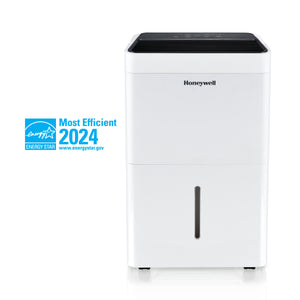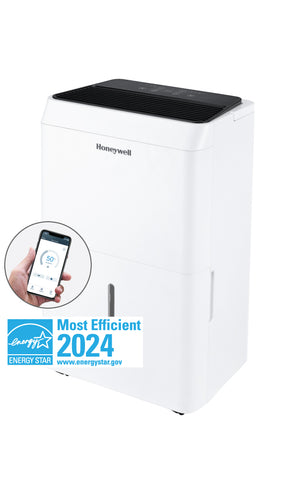
Are Dehumidifiers Actually Good for Your Health?
Have you ever noticed that the more humid it is outside, the more likely you are to experience itchy eyes, a runny nose, and a scratchy throat? The relationship between humidity and allergens—any substance that induces an allergy—is complicated, but we have learned quite a bit over the years about just how these seemingly unrelated concepts intermingle.
By utilizing technology that allows us to control humidity levels inside our homes, we're already taking a crucial step toward alleviating bothersome allergy symptoms.
In this article, we're going to take an evidence-based approach in exploring how humidity affects the number of allergens in your home as well as how humidity plays into the frequency and severity of allergy-related symptoms and conditions. Along the way, we'll provide some recommendations on how you can make your living space allergen free.
What is the main source of household allergens?
One of the most pivotal moments in the history of allergy control occurred back in 1967 when Professor Reindert Voorhorst of University Hospital, Leiden (now Leiden University Medical Centre) and his colleagues discovered dust mites were the primary allergic source in ordinary house dust (Voorhorst et al. 1967). Over the next several years, scientists noticed that dust mites had an undeniable preference for damp, muggy air.
Why would dust mites prefer humid air?
Under closer inspection, the miniature bodies of dust mites are actually made up of about 75% water, with their survival highly dependent on maintaining this high water content. In order to achieve this, dust mites absorb water vapor from the air (Arlian 1992).
Okay, but are there really more dust mites in homes with higher humidity levels?
A decade after Voorhorst’s study, a number of surveys conducted in temperate climates across the United States showed a direct link between the humidity levels of local homes and the number of dust mites. That is, the more humid the air in the house, the more dust mites were found to be lurking (Lang 1978; Murray 1979; Platts-Mills 1986).
Conversely, homes located in drier climates showed very low numbers of mites. Still not convinced? When moisture was added to the air of homes in these dry regions, the number of mites in the houses spiked dramatically (Ellingson 1995).
Clearly, mites make humid houses their homes—but how much humidity is too much?
Studies have demonstrated that the average dust mite will die from dehydration in as little as five to eleven days when the relative humidity of its environment is kept at 50% or less (Arlian 1975; Brandt 1976). Scientists have also found that removing water from the air around these pests acts as a better exterminator than several actively toxic pesticides.
In fact, maintaining the relative humidity inside your house below 50% for the majority of the day has been proven to effectively prevent the growth of mite populations and decrease allergens (Arlian et al. 1999).
Is there anything we can do to make our homes less hospitable to these allergen-dispensing nuisances?
One proven way to achieve a household humidity of less than 50%, regardless of which part of the world you live in, is by using a high-efficiency dehumidifier. Using these devices is a practical, cost-effective way to lower and maintain the humidity levels in your home, thereby reducing mite and allergen levels over time (Arlian et al. 2000).
We'd recommend an average household humidity level between 30-50% for ideal comfort and allergen control. You should keep in mind that it's not an issue if the relative humidity creeps over the 50% mark for a few hours a day, and you can target the lower end of the suggested range to suit your comfort. Relative humidity can be measured easily with a moisture meter, which can be bought at any hardware store.
Are dust mites the only allergy producers that prefer high humidity levels?
Dust mites are not unique in their ability to produce allergens, and they are far from the only allergens that thrive in humidity. In fact, increased moisture also promotes the growth of other known allergen producers, including many species of mold and fungus (Singh and Jaiswal 2013).
How do humid air and its accompanying allergens affect your health?
This question was brought to the forefront in the 1980s when doctors noted that asthma symptoms worsened when humidity increased in the ambient air of patients’ natural environments (Korsgaard 1983). Since then, humidity has been identified as a major trigger for a number of allergen-induced conditions including asthma and skin irritation, or atopic dermatitis. Not only can allergens cause these conditions, but evidence has shown that a full recovery from symptoms often doesn’t occur for several weeks after complete removal of a trigger from the environment (Platts-Mills 1997).
Does decreasing allergens with a dehumidifier also help alleviate the symptoms and health problems they cause?
The World Health Organization (WHO) estimates that asthma could affect as many as 334 million people worldwide (WHO 2014). This chronic condition is characterized by recurring attacks of wheezing and difficulty breathing, a burden that dramatically impacts quality of life and can even be fatal. During an asthma attack, allergens in the environment cause the airways in the lungs to narrow, making it more difficult for air to exit of the lungs.
In 2009, a group in Scotland set out to determine how using a household dehumidifier over the course of a year might affect asthma and its symptoms. They reported that asthma patients with a dehumidifier in their homes had an increased ability to breathe air out of their lungs in the evening compared to asthma patients living without a dehumidifier (Wright 2009). Reducing the amount of humidity in the air reduced the number of allergens in the environment, which allowed the airways of asthmatics to stay open.
How should I use a dehumidifier in my home if I suffer from allergy symptoms?
Based on the current evidence, long-term use of a household dehumidifier can decrease allergens in the environment known to trigger and acutely worsen the symptoms of asthma and other allergy-adjacent issues. Research shows that the room in which a dehumidifier is situated will experience the most substantial benefit in allergen reduction, so we recommend you run your dehumidifier in the bedroom during daytime hours to maximize the air quality where you sleep. Since all dehumidifiers contain a compressor which generates mild noise that may be disruptive for lighter sleepers, the best practice would be to then move the unit into another high-activity area of the house at night. Not only will this dry out the air and reduce the allergen count in your bedroom for when you are ready for some symptom-free sleep, but it will also lower allergen counts in your primary living areas for when you are awake and active throughout the day.
Do dehumidifiers also help prevent musty odors?
As mentioned before, several mold and fungi thrive in humid places. While we’ve already discussed the impact of mold on allergen production, they are also a common cause for unpleasant musty odors that can proliferate throughout your house. In the right conditions, mold can grow nearly anywhere, including on carpets, between walls, and in food. The Environmental Protection Agency (EPA) is quick to note that the only way to regulate mold growth in your home is to tightly control the level of moisture in the air (EPA 2016).
How can I use a dehumidifier to prevent mold growth and odors?
The same dehumidifier guidelines apply for musty smells, with a 30-50% range ideal for the prevention of mold growth and consequent odors. Keep a close eye out for condensation on the walls or windows, as this is a worrisome indicator of too much humidity. Quickly drying these surfaces and starting your dehumidifier can help to cease mold production.
How do I choose the right dehumidifier for your home?
Dehumidifiers come in a variety of sizes, and the right choice for you will depend on the size of your space and the amount of moisture you need to remove from your air measured in pints extracted per day. For smaller (500-1000 sq. ft.) rooms that are occasionally damp and musty, 30- to 40-pint dehumidifiers will likely be sufficient. Rooms larger than 2000 sq. feet with constantly visible condensation might require 60 pints or more in a dehumidifier.
Can you recommend a high-quality dehumidifier?
There are many great options available when choosing the dehumidifier that’s the right fit for you and your home, whether you're looking for a dehumidifier for your basement, living room, bedroom, or a crawl space.
Best options for medium- to large-capacity portable dehumidifiers:
Honeywell TP70PWKNR 70 Pint Portable Dehumidifier with Pump
Honeywell TP70AWKNR 70 Pint Smart Portable Dehumidifier with Wi-Fi
Honeywell TP70WKNR 70 Pint Portable Dehumidifier
Best options for small- to medium-capacity portable dehumidifiers:
Honeywell TP50WKN 50 Pint Portable Dehumidifier
Honeywell TP50WKN 50 Pint Smart Portable Dehumidifier with Wi-Fi
Dr. Peter Grossman earned his MD from the Virginia Tech Carilion School of Medicine, trained in Internal Medicine, and is now a full-time medical writer and consultant. He is a strong advocate of evidence-based medicine and its application in improving everyday life for patients.
References
Arlian LG, A. A. (n.d.). Lowering humidity in homes reduces dust mites and their allergens. J Allergy Clin Immunol, 99-104.
Arlian LG, N. J.-M. (1999). Reducing relative humidity to control the house dust mite Dermatophagoides farinae. J Allergy Clin Immunol, 852-6.
Arlian, L. (1992). Water balance and humidity requirements of house dust mites. Exp Appl Acarol, 15-35.






